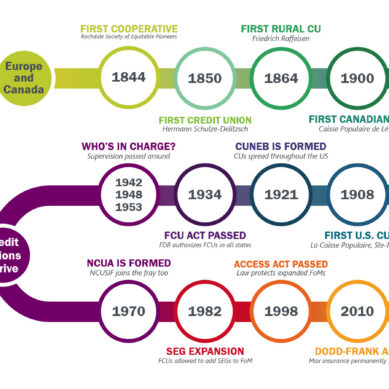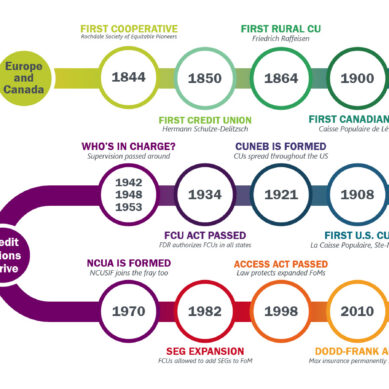“The cooperative difference.”
I’m sure you’re all familiar with that phrase. More than likely, you’ve said it yourself a time or two. It is one of our industry’s strongest mottos. We plaster it on our marketing materials, in our mission statements, and even on our branch walls. But what does it mean? What truly is the cooperative difference? Can you identify it?
Ask anyone in the credit union world, and nine times out of ten, I’d wager the response would be our not-for-profit, member-driven, cooperative structure, said with a mix of pride and confidence. These values comprise the foundation on which credit unions were laid. The cooperative difference and the seven principles embodied within that difference define our industry—take those away, and credit unions would quickly become indistinguishable from banks.
Credit unions easily recognize how the cooperative spirit makes an immeasurable difference in their own operations, creating a line between them and other financial institutions, so why then do they struggle to recognize that difference or embrace it when it comes to selecting their partners? When cooperative partners exist, what makes a credit union turn against that difference to select a for-profit vendor instead?
Why choose cooperative partners
By forgoing partnerships with cooperatives in favor of for-profit businesses, credit unions become the epitome of talking the talk but failing to walk the walk. Exemplifying the cooperative difference should not be reduced to a marketing tool; it should be a core component of each credit union. It should influence key decisions made by leadership, including decisions on which organizations to do business with.
Striving to emulate the credit union business model, cooperative CUSOs and cooperative vendors exhibit the same traits credit unions themselves are proud of. They prioritize collaboration, member success, and industry support over profits. Unlike for-profit companies, a cooperative partner will keep your credit union and its members’ best interests at the forefront of conversations and decisions and can create greater access to products and technology while simultaneously providing a network of support and shared resources.
For credit unions, partnerships are not merely practical business decisions; they are and should be a reflection of the qualities they value in their organization and others. Selecting a partner that prioritizes profit over people says something about a credit union’s values, and ultimately, will not bring the kind of quality partnership that will serve the credit union and its members for the better.
Consider the litany of reasons your credit union would recommend a potential member choose your credit union over a bank or a flashy neobank. Most likely you would start with something along the lines of how credit unions are not-for-profit and therefore put members’ needs before their bottom line. Credit unions anticipate that members will choose their institution because of the cooperative difference even when they themselves do not choose the cooperative difference.
If you wouldn’t urge a member to turn away from a cooperative financial institution for one driven by profit margins, then why would you, the credit union, make the choice to do just that?
Supporting the cooperative system
A critical component of that cooperative difference is our symbiotic nature. As cooperatives, credit unions aren’t in competition with one another; instead, they work together to lift each other up. We often see this enacted through collective resources such as shared branching and ATMs. This is because each credit union is more than the sum of its parts; it is a piece of the cooperative movement as a whole. Therefore, the movement—and every cooperative inside of it—is best served when every component is at its strongest.
But the cooperative moment is not comprised solely of credit unions—trade organizations, CUSOs, and other cooperative partners are all included within the system. When credit unions seek out a partnership with another cooperative, it is not just the two that benefit; the cooperative movement receives a boost as well. By working together, the two cooperatives achieve more than the simple buying and selling of a product, but create a true, trusting partnership that brings value to both and strengthens the movement as well.
When credit unions and cooperative partners thrive, so does the cooperative movement. The credit union becomes part of the rising tide that will lift all boats.
Our partners reflect our values
The values your credit union exemplifies the most are the same values you should be seeking in your partners and vendors. Our cooperative difference, spirit, and principles that credit unions recommend members choose day in and day out should not be dismissed when it comes time for the credit union to choose where to place its business, trust, and member information.
As you go about the rest of your week, I would urge you to consider which companies your credit union chooses to hand its business to and ask yourself if you see your credit union’s mission reflected in their values. Do you see the cooperative difference in how they work with you? Do you see a dedication to the wellbeing of your institution and its members? If the answer is no, it is time to reevaluate your partnerships and seek out one that more closely aligns with your mission, remembering that the right cooperative partner can strengthen and support both your credit union and the cooperative movement.
























































